MAXXI BVLGARI PRIZE 2024
the exhibition’s closing has been extended to Sunday 9 March 2025
sala Gian Ferrari
curated by Giulia Ferracci
Monday closed
Tuesday to Sunday 11 am – 7 pm
Monday 8 December 11 am > 7 pm
Wednesday 24 December 11 am > 4:30 pm
Thursday 25 December closed
Wednesday 31 December 11 am > 4:30 pm
Thursday 1 January 11 am > 7 pm
Monday 5 January 11 am > 7 pm
Tusday 6 January 11 am > 7 pm
– for young people aged between 18 and 25 (not yet turned 25);
– for groups of 15 people or more;
– La Galleria Nazionale, Museo Ebraico di Roma ticket holders;
– upon presentation of ID card or badge: Accademia Costume & Moda, Accademia Fotografica, Biblioteche di Roma, Centro Sperimentale di Cinematografia, Enel (for badge holder and accompanying person), FAI Fondo Ambiente Italiano, Feltrinelli, Gruppo FS, IN/ARCH Istituto Nazionale di Architettura, Sapienza Università di Roma, LAZIOcrea, Palazzo delle Esposizioni, Amici di Palazzo Strozzi, Accademia Nazionale di Santa Cecilia, Scuola Internazionale di Comics, Teatro Olimpico, Teatro dell’Opera di Roma, Teatro di Roma, Università degli Studi di Roma Tor Vergata, Youthcard;
valid for one year from the date of purchase
– minors under 18 years of age;
– myMAXXI cardholders;
– on your birthday presenting an identity document;
– upon presentation of EU Disability Card holders and or accompanying letter from hosting association/institution for: people with disabilities and accompanying person, people on the autistic spectrum and accompanying person, deaf people, people with cognitive disabilities and complex communication needs and their caregivers, people with serious illnesses and their caregivers, guests of first aid and anti-violence centres and accompanying operators, residents of therapeutic communities and accompanying operators;
– MiC employees;
– journalists who can prove their business activity;
– European Union tour guides and tour guides, licensed (ref. Circular n.20/2016 DG-Museums);
– 1 teacher for every 10 students;
– AMACI members;
– CIMAM International Committee for Museums and Collections of Modern Art members;
– ICOM members;
– from Tuesday to Friday (excluding holidays) European Union students and university researchers in art history and architecture, public fine arts academies (AFAM registered) students and Temple University Rome Campus students;
– IED Istituto Europeo di Design professors, NABA Nuova Accademia di Belle Arti professors, RUFA Rome University of Fine Arts professors;
– upon presentation of ID card or badge: Collezione Peggy Guggenheim a Venezia, Castello di Rivoli Museo d’Arte Contemporanea, Sotheby’s Preferred, MEP – Maison Européenne de la Photographie;
limited seating; it is mandatory to arrive at the infopoint 15 minutes before the start time indicated on the ticket; the experience lasts approximately 45 minutes
limited seating; it is mandatory to arrive at the infopoint 15 minutes before the start time indicated on the ticket; the experience lasts approximately 45 minutes
MAXXI’s Collection of Art and Architecture represents the founding element of the museum and defines its identity. Since October 2015, it has been on display with different arrangements of works.

the exhibition’s closing has been extended to Sunday 9 March 2025
sala Gian Ferrari
curated by Giulia Ferracci
Monday closed
Tuesday to Sunday 11 am – 7 pm
Monday 8 December 11 am > 7 pm
Wednesday 24 December 11 am > 4:30 pm
Thursday 25 December closed
Wednesday 31 December 11 am > 4:30 pm
Thursday 1 January 11 am > 7 pm
Monday 5 January 11 am > 7 pm
Tusday 6 January 11 am > 7 pm
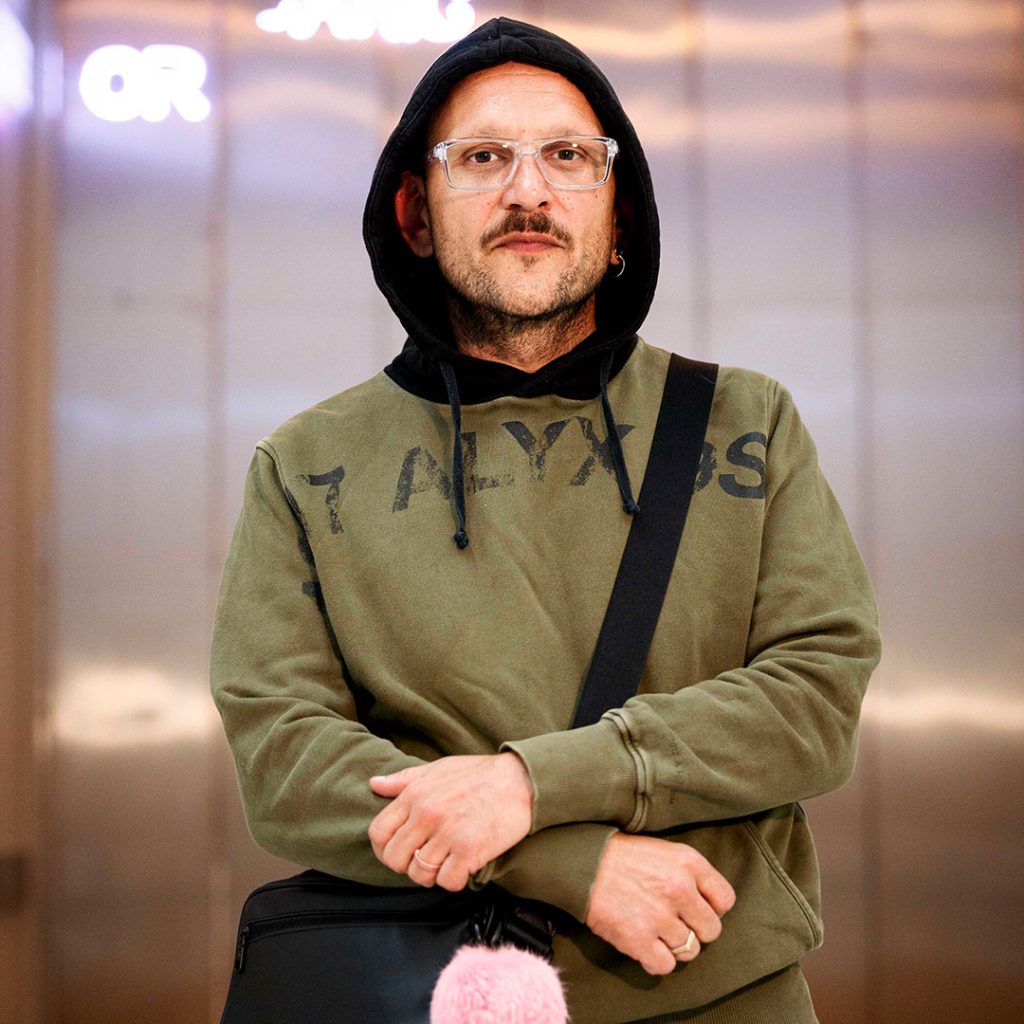
Riccardo Benassi is a visual artist known for his interdisciplinary approach, which mixes writing, sound and new technologies to investigate the relationship between nature and the digital world. Conceived for the MAXXI BVLGARI PRIZE, ASSENZAHAH ESSENZAHAH (2024) is a work set up in the Gian Ferrari hall, inside the MAXXI elevator.
There, two robotic dogs perform choreographies conceived by the artist and programmed by engineer Edoardo Todde with the support of the Complex Systems Laboratory directed by Prof. Alessandro Rizzo. Department of Electronics and Telecommunications of the Turin Polytechnic. On the steel walls, a laser light projects an interior monologue that alludes to how our digital traces build indelible funerary monuments destined to survive on the Internet beyond earthly life. The work also features a piece of music composed by the artist. With its crystalline, sweeping tones, the sound generates a metaphorical space where the boundaries between human and artificial bodies dissolve.
With this work, the artist invites the viewers to reflect on the impact of new technologies on humans, society and emotional relations.
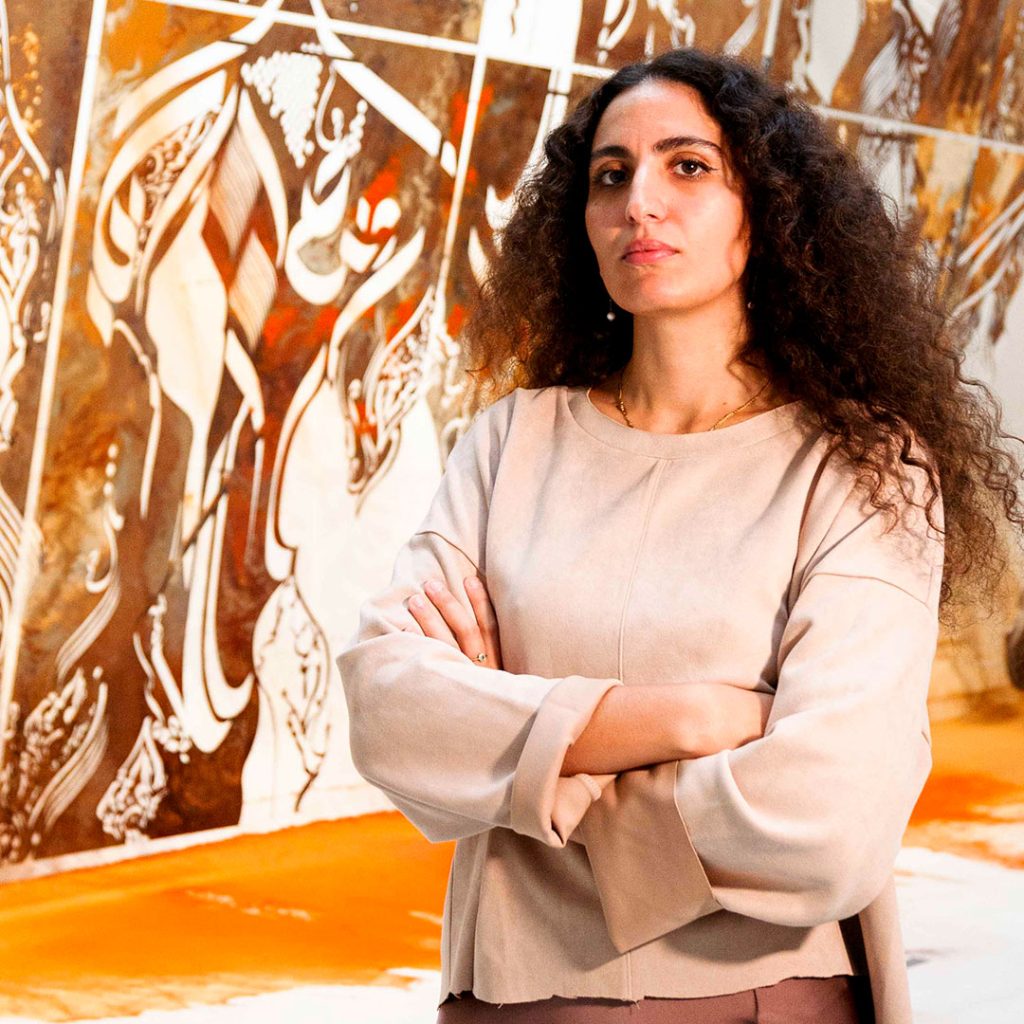
Monia Ben Hamouda is a figurative artist and sculptor. Her artistic prac tice reflects the complexity of her intercultural identity. Drawing inspiration from her Italian and Tunisian roots and cultural syncretism, the artist reinvents some established aesthetic canons through a process of sign contamination.
Theology of Collapse (The Myth of Past) I-X (2024), created on the occasion of the MAXXI BVLGARI PRIZE, is an installation consisting of ten laser-cut iron panels, which outline motifs inspired by Islamic calligraphy and mosque shapes. The signs have been reworked by the artist through the use of Al. Painted with mixed techniques that include the fragrant spices of paprika, cinnamon and hibiscus, the panels are installed in a reversed fashion on the back wall of Zaha Hadid’s gallery, acting as an impassable curtain to passage but not to view.
Rather than standing, the work seems about to collapse, prompting reflection on the decay of cultural and religious structures and highlighting the fragility of contemporary identities.
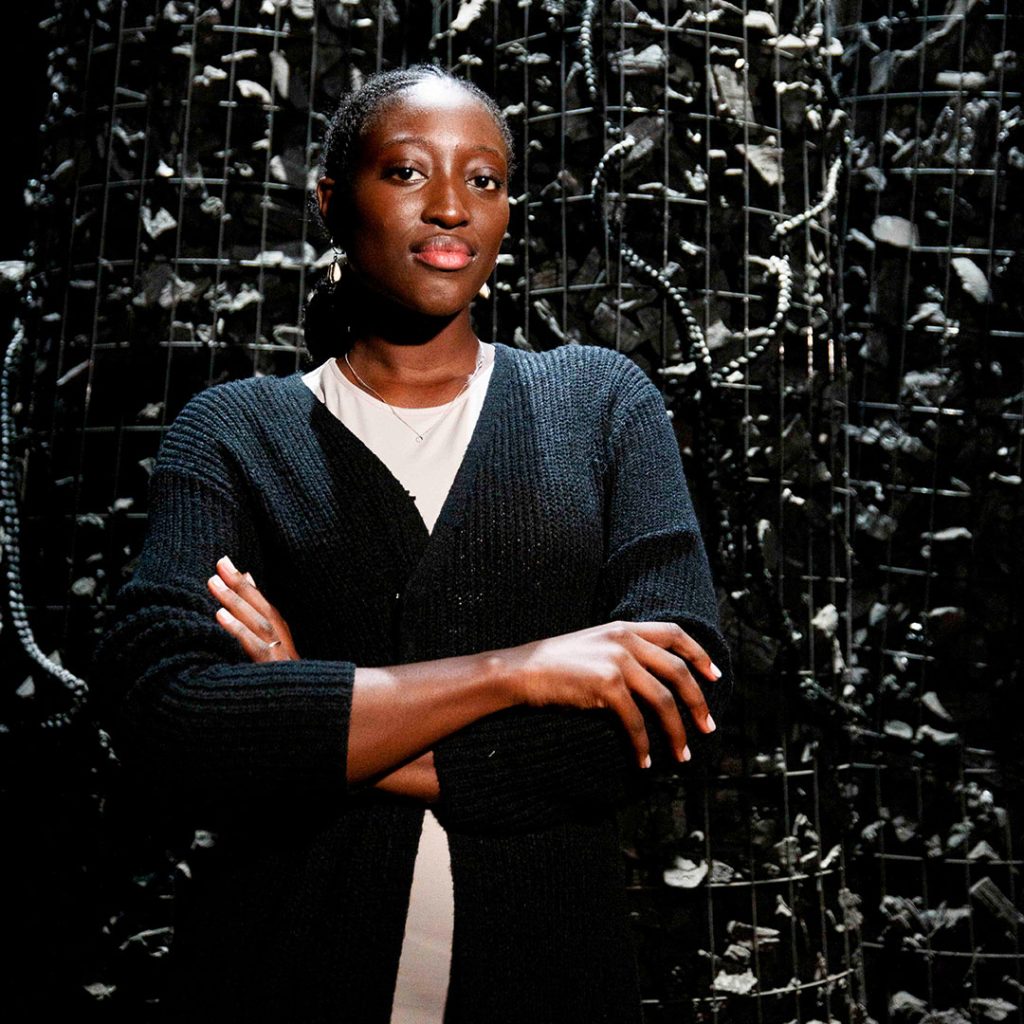
Binta Diaw is an ltalian-Senegalese figurative artist. Her artistic practice reflects on black female bodies in Western cultural imagery, interweaving her own personal life experience with a reflection on migration and colonialism. In her works, she unearths stories and memories of African diasporic communities that are misunderstood or silenced, counteracting the neglect and invisibility imposed by Western policies.
Juroom ñaar (2024) is a work realised for the MAXXI BVLGARI PRIZE. It is inspired by a tragic historical event dating back to 1819 when the women of the Senegalese village of Nder chose collective suicide to escape the attack of the Mauri warriors and the slavery that would have followed. The installation consists of seven columns made of charcoal and commemo rates the bodies of the seven women who, disguised as men, sacrificed themselves by burning alive. Around the seven sculptures are knotted hair braids evoking resilience and the memory of that sacrifice. Sounds and voices in the Wolof language, representing the oral tradition of the local storytellers (griots), accompany visitors by reflecting on the struggle for human dignity.
The choice of materials and motifs reflects tradition and culture identity and transforms the work into a tribute to resistance against all forms of oppression.

The winning project of the first MAXXI BVLGARI PRIZE FOR DIGITAL ART, And We Thought (2021-ongoing), by Roberto Fassone, analyses the relationship between art and artificial intelligence, questioning the concept of authorship and AI’s creative capacity. In his artistic practice, Fassone reflects on creative processes and the perception of reality with an ironic and playful approach. Through performance, video, and site-specific installations, he explores the boundaries of imagination, creating fabulations, imaginative narratives, parallel realities, and paradoxical worlds.
And We Thought explores creativity-related issues, the collaboration between human and algorithmic intelligence and the perception of reality, demonstrating how technologies can amplify and enrich the creative process.
The work offers new insights into rethinking the role of the artist, the concept of authorship, and the aesthetic experience itself. It does not limit itself to using the digital as a tool but reflects on how technologies influence the perception of reality, collective memory, and interpersonal relationships.


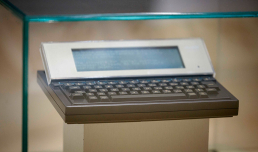


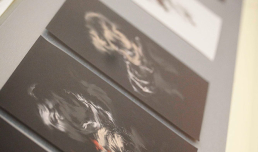
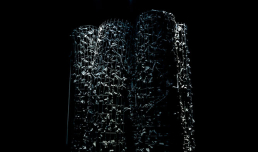
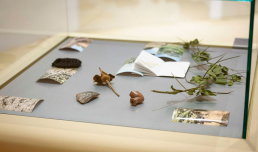

The project for the support and promotion of young artists, which has united MAXXI and Bvlgari since 2018 and has launched many new talents on the international scene over the years, returns for its fourth edition.
Riccardo Benassi, Monia Ben Hamouda and Binta Diaw are the three finalists.
The exhibition opens with ESSENZAHAH ESSENZAHAH by Riccardo Benassi. Inside the museum lift, two robotic dogs perform choreographies created by the artist, moving through space accompanied by a musical composition and laser text projected on the walls.
Binta Diaw’s work, steeped in personal and collective memory, is at the centre of the space: it is entitled Juroom ñaar. It is inspired by a historical event of 1819 commemorated by the artist with seven columns of coal. Seven were, in fact, the women of the Senegalese village of Nder who died by setting themselves on fire to avoid slavery following the Moorish invasion.
Monia Ben Hamouda’s Theology of Collapse (The Myth of Past) I-X concludes the exhibition. The work consists of ten laser-carved iron panels with motifs inspired by Islamic calligraphy and mosques. The plates are installed on the gallery’s back wall, creating a collapsing effect that evokes the fragility of contemporary identities.
On 17 January 2025, the international jury awarded the prize to artist Monia Ben Hamouda: for the ability to engage with the Museum’s space and interact with materials, integrating the use of contemporary and traditional technologies; for the determination and rigour in her work, which represents a clear moment of growth in her artistic research; and for addressing with profound depth the collapse of our times through an unusual and evocative approach. Her work, Theology of Collapse (The Myth of Past) I-X will become part of the MAXXI Museum’s Collection.
New in this edition is the MAXXI BVLGARI PRIZE for Digital Art, an award to celebrate works that explore the complex and increasingly intertwined relationship between art, technology and innovation. It was won for the first time by Roberto Fassone’s work, And We Thought, which analyses the relationship between art and artificial intelligence, questioning the concept of authorship and the creative capacity of AI – on show from 17 January to 2 March 2025 in the Museum lobby.
Riccardo Benassi
Monia Ben Hamouda
Binta Diaw
Roberto Fassone